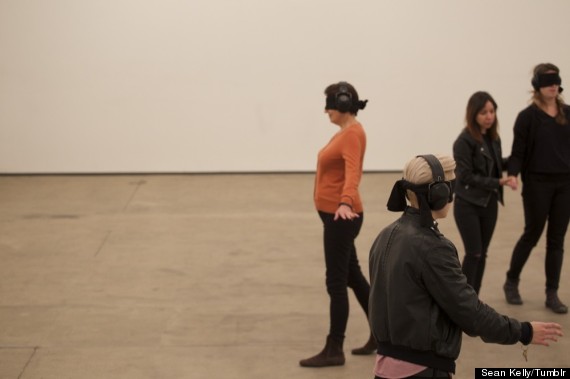Much of art today has been diminished to a purely aesthetic pleasure, and one that many opt to visit for the promise of self-publicity. Think of Jeff Koons’ retrospective at the Whitney this summer. Whether you visited the exhibit or not, you likely knew it was there, as your Instagram and Facebook feeds filled up with "the Selfie of Summer."
Other recent viral art sensations in New York included Yayoi Kusama’s “Fireflies on the Water” and Random International’s “Rain Room” at MoMA. Both exhibitions, like the Koons retrospective, were exploited for their photographic beauty on social media. Taking a photo of ourselves in an art exhibit serves multiple purposes -- not only do we appear engrossed in the New York art world to our followers, but it also makes for a great profile picture.
But what if we just stopped, for one minute or one hour, and actually allowed ourselves to experience art first-hand, sans electronic interference? If anyone is a strong advocate for the fully immersive and personally challenging experience of art, it is the Godmother of Performance Art herself, Marina Abramovic.
With her latest exhibit, “Generator,” she asks something specific of her audience: to remove all electronic devices and succumb to (almost) complete blindness and deafness. So when you enter Sean Kelly Gallery you’re asked to first sign a waiver permitting the gallery to photograph you (more on that later), and to stow away your items in a locker -– cell phone and watches included. Eventually a gallery assistant ties a black cloth over your eyes, hindering all sight save for a sliver of light beneath the bridge of your nose, and places noise-canceling headphones on your head. You’re then led gently by an assistant for a few steps until, finally, all human contact is lost. You are alone, blind, sounds muted, and whatever you do next is entirely up to you.

Such an experience may sound baffling, maybe even pretentious or uncomfortable to some unfamiliar with or skeptical of performance art. Especially the radical, provocative and controversial type Abramovic has been known for since the 1970s. Some may have a rather forgettable experience, such as Ken Johnson of The New York Times, while others may have a deeply powerful, personal and emotional experience. I had the latter.
As I began taking my very first steps into the unknown and unseen gallery space, a sudden stifling fear began to bubble from my chest. All I could hear was the growing pressure of my breath as I walked slowly, cautiously, unsure of what I was supposed to be thinking or supposed to be experiencing. Eventually I made contact with a cold plaster wall and latched onto it like a piece of ship wreckage in an open sea. I walked along and clung to this wall, to the security and closure it gave me, as I began to see nothing but my insecurities and my innermost anxieties presented to me clearer than the blanket of black across my eyes. Turning away from the walls, fighting contact with them, attempting to engross myself in the openness of the space, I was suddenly overcome with a rush of tears I hadn’t expected.
I spent nearly 30 minutes in “Generator” and over that period of time my previously timid outstretched arms fell weightlessly to my sides. At some points, I made contact with other people in the gallery. Smelling the perfume of what I assumed belonged to a nearby woman, I drifted towards her, reached up and touched her shoulders. We grab hands and she squeezed mine for a moment. I squeezed back as we stood there facing each other in silence. Then she was gone. For the rest of my visit, I sat on the floor in solitude, I stretched my arms as I walked in circles, imagining myself flying I explored as much of the space with my mind and my hands as I could.
No one, of course, will experience “Generator” the way I did, nor will they experience it as Johnson did or any other neighboring gallery visitor. The beauty of Abramovic’s piece is that it creates an empty space for you to fill with yourself, as much as you want for as long as you want. It asks nothing more of its visitors than to simply let go, to embrace the unfamiliar and the unknown, whether it be a stranger you make contact with or the inability to share your experience with anyone but yourself. “Generator” forces us to be alone with ourselves, to feel the buzzing energy of our bodies and minds, to face ourselves in a way that our currently technology-suffused society hinders us from recognizing.

There is still the one problematic aspect of “Generator,” however, and that is the exhibit’s Tumblr that posts live stills of the blinded visitors within the gallery. You can go home after your visit and search for images of yourself within the white-walled space. Some friends of mine have turned these into their profile pictures, while I am equally guilty of posting about my experience on social media, urging others to visit (as well as including photos of myself in this story). It is a bit hypocritical to advocate a technology-free experience and promote it via technology, proving that we're still obsessed with injecting ourselves into art for all to see.
While Abramovic’s intentions for the Tumblr are still unclear to me, it would be ignorant to deny the significance and influence that social media has in our lives. Perhaps as long as we’re abstaining from it during our encounter with the art, then engaging with it afterwards is excusable? Or perhaps not, and this merely reflects the difficulty our culture faces with embracing simplicity and aloneness.
Still, it is the actual time spent in “Generator” that truly matters. For a period of time we are stripped of all external interferences, thrown into an unknown environment, deprived of nearly half of our senses, and given the opportunity to create our own experience. Abramovic may have removed herself from her art, which feels paradoxical to an artist who has based so much of her legacy on challenging her own physicality and exploring the shared experienced between artist and audience. But as Abramovic told me after my time in “Generator,” the art is no longer about her, but about us. She is giving back that which she has come to experience and understand through art. She wants audiences to have their own chance at exploring it.
Sans Abramovic, does “Generator” as a piece of art turn us into artists? Not necessarily. But it is does what all good art should: enable us to experience, contemplate and question ourselves in a way we might not have in our daily lives. And for that, “Generator” is worth visiting.
“Generator” continues through Dec. 6 at Sean Kelly Gallery in New York City.
